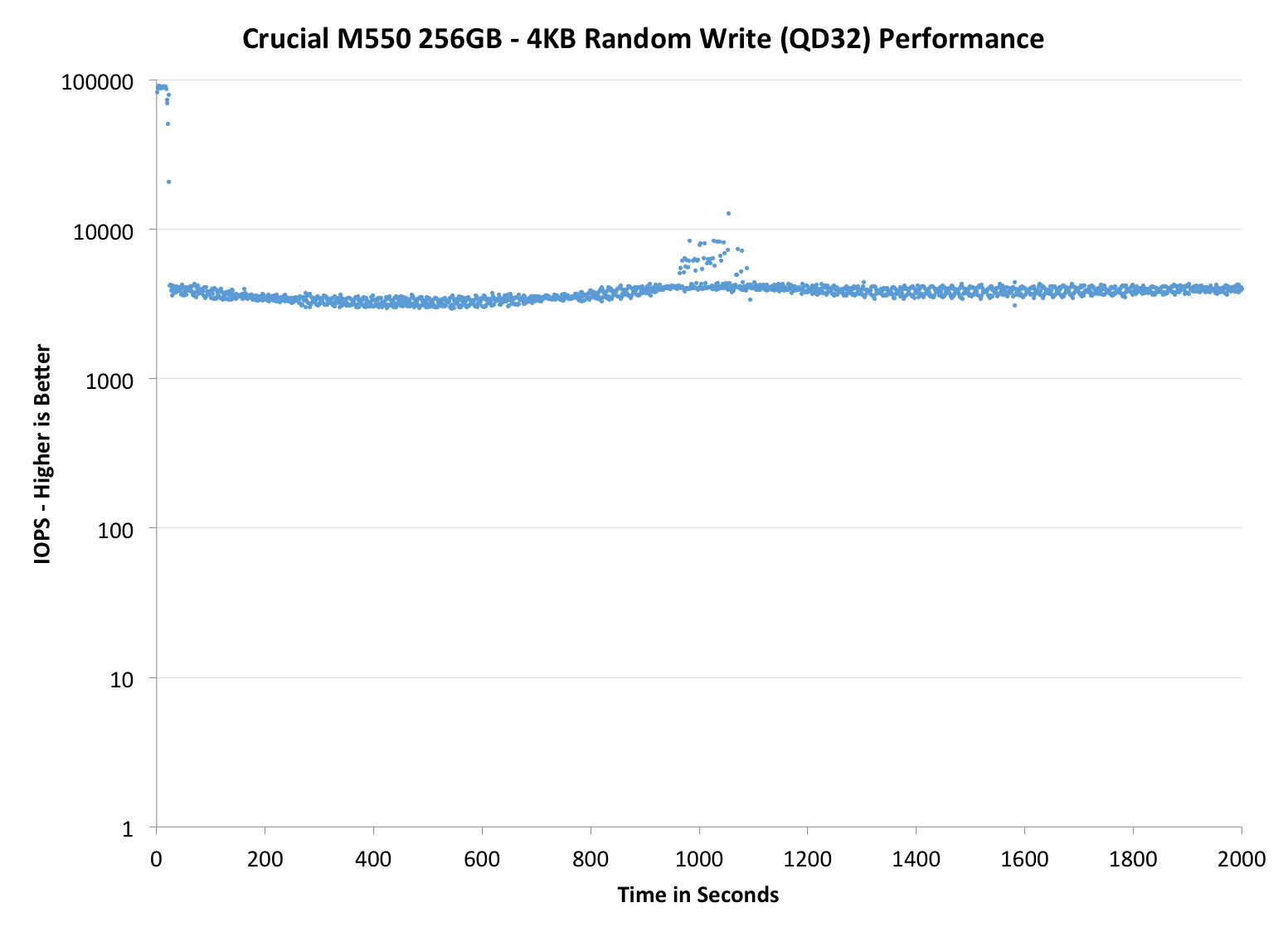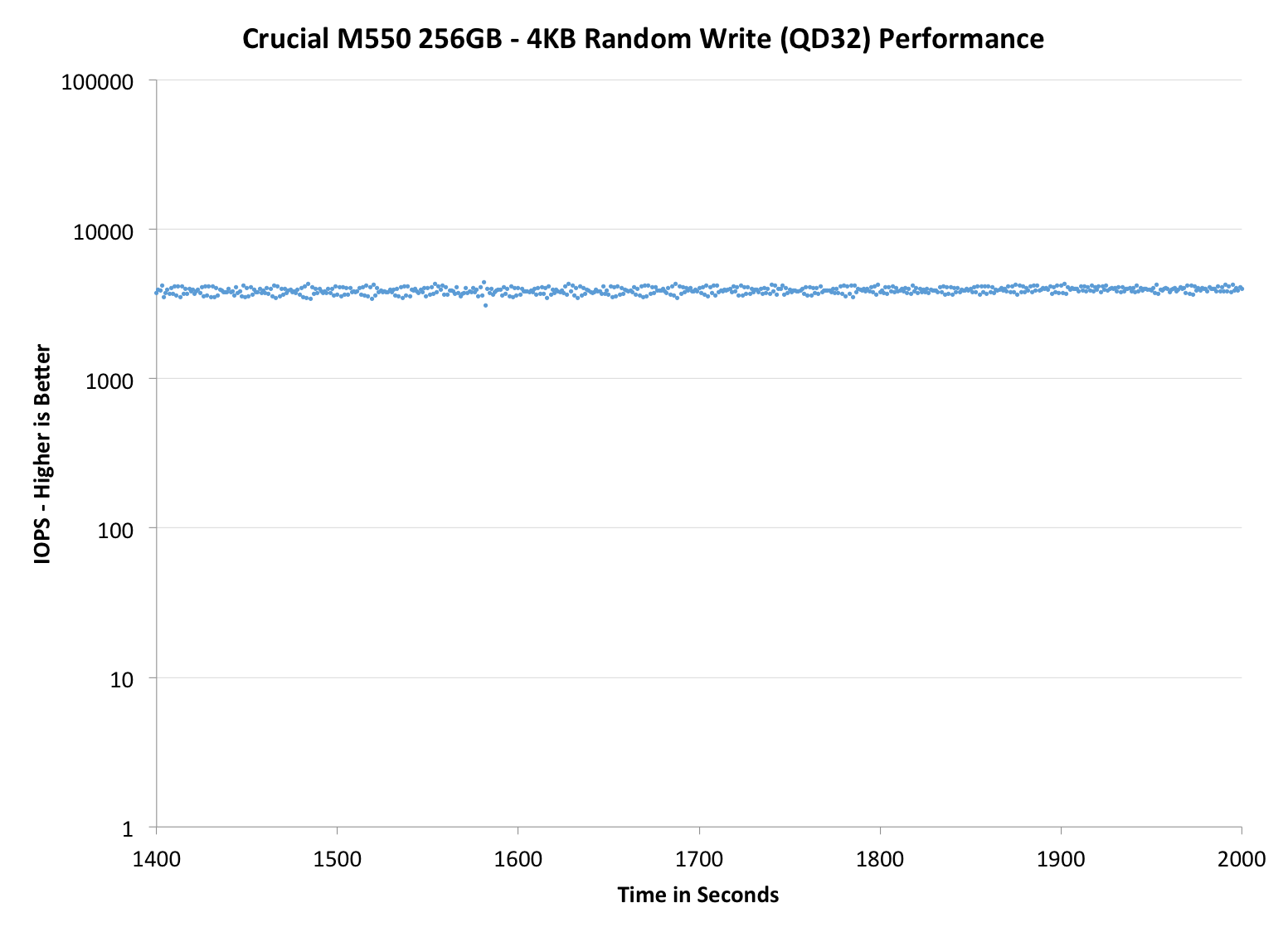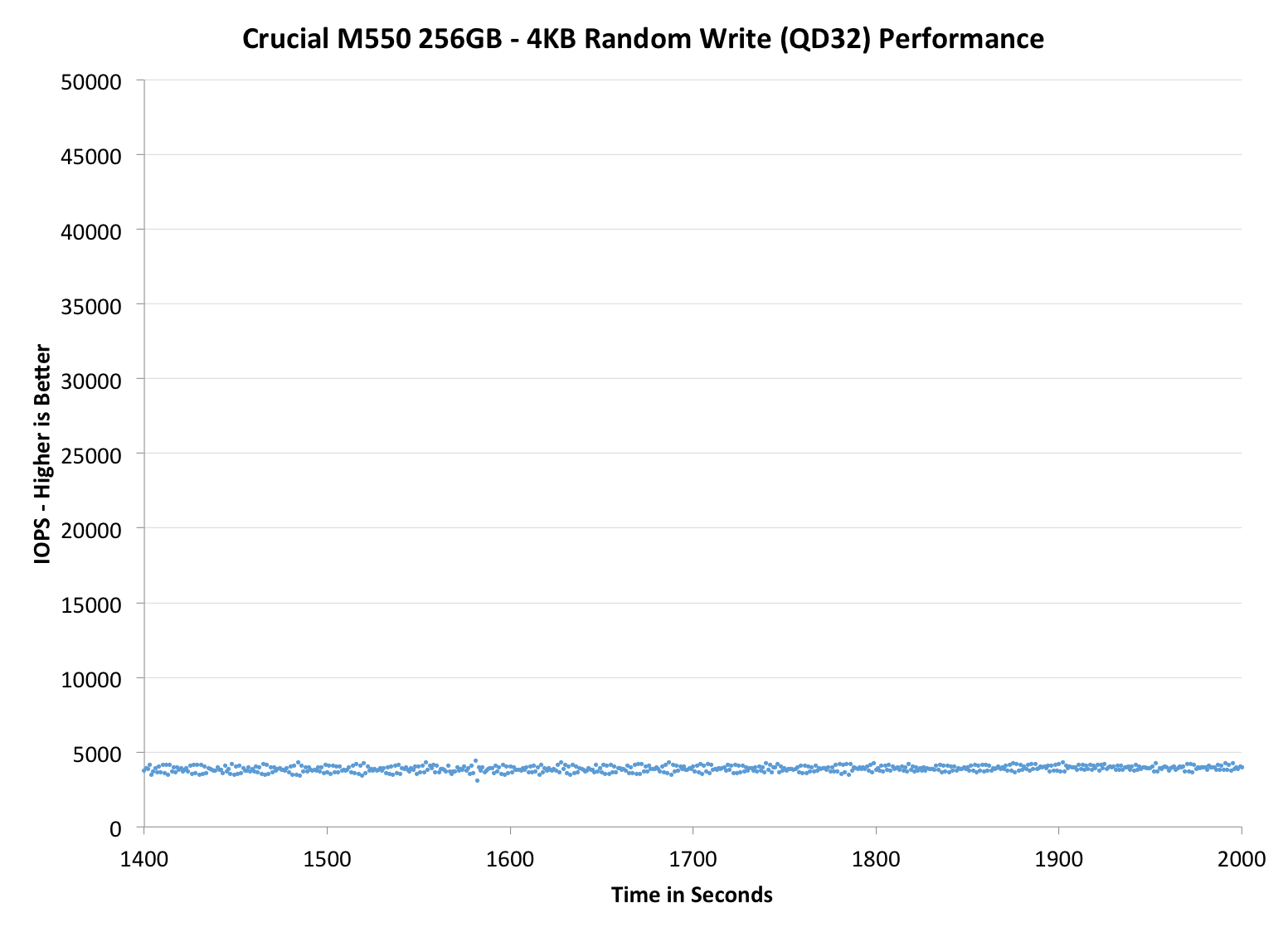Crucial M550 Review: 128GB, 256GB, 512GB and 1TB Models Tested
by Kristian Vättö on March 18, 2014 8:00 AM ESTPerformance Consistency
Performance consistency tells us a lot about the architecture of these SSDs and how they handle internal defragmentation. The reason we don’t have consistent IO latency with SSD is because inevitably all controllers have to do some amount of defragmentation or garbage collection in order to continue operating at high speeds. When and how an SSD decides to run its defrag or cleanup routines directly impacts the user experience as inconsistent performance results in application slowdowns.
To test IO consistency, we fill a secure erased SSD with sequential data to ensure that all user accessible LBAs have data associated with them. Next we kick off a 4KB random write workload across all LBAs at a queue depth of 32 using incompressible data. The test is run for just over half an hour and we record instantaneous IOPS every second.
We are also testing drives with added over-provisioning by limiting the LBA range. This gives us a look into the drive’s behavior with varying levels of empty space, which is frankly a more realistic approach for client workloads.
Each of the three graphs has its own purpose. The first one is of the whole duration of the test in log scale. The second and third one zoom into the beginning of steady-state operation (t=1400s) but on different scales: the second one uses log scale for easy comparison whereas the third one uses linear scale for better visualization of differences between drives. Click the buttons below each graph to switch the source data.
For more detailed description of the test and why performance consistency matters, read our original Intel SSD DC S3700 article.
 |
|||||||||
| Crucial M550 | Crucial M500 | Intel SSD 730 | SanDisk Extreme II | Samsung SSD 840 EVO | |||||
| Default | |||||||||
| 25% Spare Area | - | ||||||||
I can't say I'm very pleased with the IO consistency of the M550. There is a moderate increase (~4K IOPS vs 2.5K in M500) in steady-state performance but other than that there isn't much good to say. All the other higher-end drives run circles around the M550. I should note that the M550 does have considerably less over-provisioning than the other drives but even at 25% OP the results aren't pretty. There is huge variation in performance and the graphs with additional spare area certainly look quite abnormal, but the IOPS is still mostly below 5000. There are peaks of over 50K IOPS too but personally I would prefer a steady line (like the SSD 730) instead of this constant up and down. In client workloads the variation in IOPS isn't as critical as in the enterprise (where predictable performance is a must) but there can be an impact on performance in IO intensive scenarios.
 |
|||||||||
| Crucial M550 | Crucial M500 | Intel SSD 730 | SanDisk Extreme II | Samsung SSD 840 EVO | |||||
| Default | |||||||||
| 25% Spare Area | - | ||||||||
 |
|||||||||
| Crucial M550 | Crucial M500 | Intel SSD 730 | SanDisk Extreme II | Samsung SSD 840 EVO | |||||
| Default | |||||||||
| 25% Spare Area | - | ||||||||
TRIM Validation
To test TRIM, I took a secure erased drive and filled it with sequential data. Then I tortured the drive with 4KB random writes (QD32) for 30 minutes followed by a TRIM command (quick format in Windows). Finally I measured performance with HD Tach to bring you the graph below:
And as you should expect, TRIM works.











100 Comments
View All Comments
hojnikb - Thursday, March 20, 2014 - link
Thats only taking flash endurance into account. That doesn't mean controller wont crap on you years sooner.q.epsilon.p - Sunday, April 6, 2014 - link
Dude given that the 500M 480 and 550M 512 models are so different in price and so similar in performance I would go for the 480BG.Although the 500m 240 and 500m 120 perform much slower, but they were always slower compared to the competition so you had that information available before buying them. But considering its write speed where they really suffered I wouldn't have been much concerned.
and tbh you are not really going to notice the difference without benchmarks and the price difference is big enough to make it worth it.
Homeles - Tuesday, March 18, 2014 - link
The M500 being phased out doesn't make sense. Technically the M500 is more advanced with its 128Gb dies, despite its slower performance.elerick - Tuesday, March 18, 2014 - link
At first glance I tend to agree that this is a middle of the pack SSD. I however do seriously consider the power loss protection worth its weight in gold. I have a Samsung 830 and these days I value reliability above "good enough" performance. Once PCI-E SSD starts producing consumer priced drives I'll go that route.Death666Angel - Friday, March 21, 2014 - link
Can we boot off PCIe SSDs yet (consumer grade Windows)?hojnikb - Tuesday, March 18, 2014 - link
I really expected better consistency, but well... Maybe next time (or next firmware update ?).Although its nice to see they were able to boost write speed so much. Looks like smaller dies do pay off.
PS:
Anyone knows what native write accelaration stands for ? At first i though it was something like turbowrite (not knowing they will use 64Gbit flash) but this does not appear to be the case ...
Kristian Vättö - Tuesday, March 18, 2014 - link
Crucial specifically said they don't have an SLC or DRAM buffer and the write performance should be the same across all LBAs (the HD Tach graph shows that this is true). To me it sounds like the Native Write Acceleration is just a marketing trick aimed at Samsung and others who use buffers to boost performance.hojnikb - Tuesday, March 18, 2014 - link
Yeah it appears so.It really nice to see, that they aren't using any nasty tricks like turbowrite, just to inflate numbers.
jospoortvliet - Thursday, March 20, 2014 - link
I think turbowrite is an awesome idea - it helps exactly where consumers need it... Short write bursts. Sure, not that interesting for pro use perhaps but isn't that the point of consumer products?hojnikb - Thursday, March 20, 2014 - link
Awsome idea for marketing department maybe. Considering that your avarage joe only looks at the sequential speeds, it makes EVO compared to lets say m500 a way way better drive, even though in reality thats not the case.Its not like turbowrite is bad or anything (i think it a great solution for "slow" write devices such as TLC) but i just hate that they are fooling people (they could easily market both normal speeds and turbo speeds)